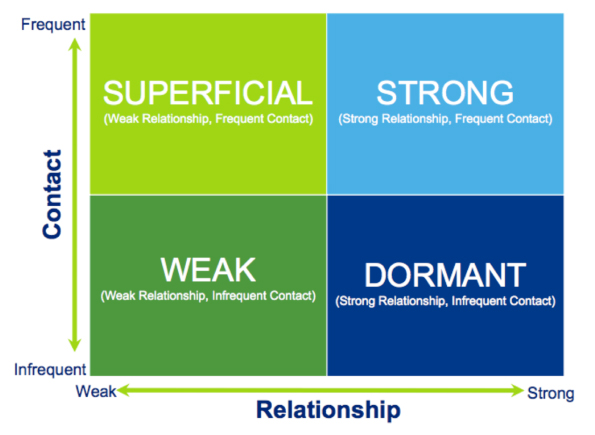How would you describe your LinkedIn network? Is it comprised of people you currently know? People youused to know? People you don’t know? We all have a network of sorts, but the quality of our network enhances or impairs our ability to maximize the business benefits of LinkedIn.
According to Dunbar’s Law our neocortex is built to sustain a social network of around 150 connections. I’m not saying you should start pruning friends. Social networks would never condone such heresy (except for Path). Instead, think hard about your existing network and the quality of relationships you maintain. If our ability to maintain relationships is limited, we need to do a better job of managing the strength of our network.
Using two variables, frequency of contact and personal relationship, we can easily segment our existing networks. Through this segmentation process, we can gauge the strength of our existing network and determine the best course of action to help us build a strong and prosperous network. Most of the contacts in your network fall into one of four categories:

So, what does your network look like? For most advisors, it’s a blend of the above categories. In working with an advisor recently, she realized that her LinkedIn connections were mostly “dormant” or “weak.” She obviously had some work ahead of her. After you segment your own network, here are a few tips on how to manage each category and power-up your existing network:
Strong Connections
These are people you know personally and see regularly. Your objective is to build a network rife with “strong” connections. Nourish this group and leverage them for introductions to prospects and COIs. But make sure you don’t abuse these connections. It may be tempting to approach them regarding business on a regular basis, but do this sparingly. Also, think about how you can add reciprocal value to them.
Dormant Connections
These are people you knew well in the past, but you no longer associate. This might be an old colleague, friend from college, or former center-of-influence. To transition this segment to “strong” connections, devise a plan to increase your contact and rekindle the relationship.
According to Adam Grant, Wharton Professor and author of Give and Take, “dormant” ties present the largest opportunity. Why? These people have additional ties and relationships of which you are unaware. They present a fresh network that has yet to be harvested.
Superficial Connections
Superficial connections are people with whom you have regular contact but a shallow relationship. These are people with whom you exchange pleasantries at networking events. You’ve never met in person but interact with them online. To transition these connections from “superficial” to “strong” you need to develop a deeper connection. Get to know them personally and then schedule some one-on-one personal contact in a different environment.
Weak Connections
If there is no opportunity, no commonalities, no personal relationship, and no desire to nurture – disconnect. Weak connections take the most energy to develop into “strong” connections. They require more contact and more personal relationship development. Determine which connections you are willing to nourish and which ones you plan to jettison. Connections that could offer business opportunity in the future may be worth the time and effort.
Your ability to acquire new clients with LinkedIn is contingent upon the quality of your network. Take your LinkedIn network seriously; your future business depends upon it.
Kevin Nichols is a thought leader with The Oechsli Institute, a firm that specializes in research and training for the financial services industry. Follow him on twitter @KevinANichols| www.Oechsli.com






